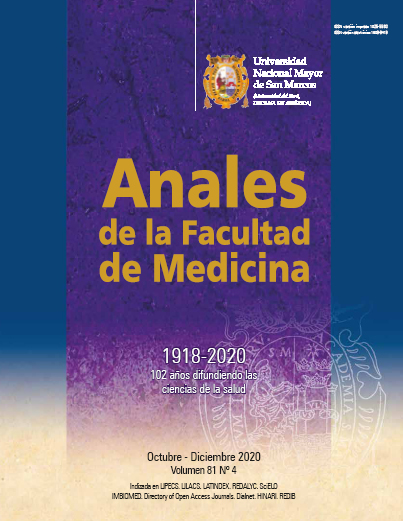Comparison of calcium bioaccessibility in cow’s milk, sesame seeds (Sesamun indicum) and almond (Prunus amygdalus)
DOI:
https://doi.org/10.15381/anales.v81i4.18932Keywords:
Biological Availability, Calcium, Calcium, Dietary, Milk, Seeds, Sesamum, PrunusAbstract
Introduction. The bioavailability of a nutrient reflects the fraction available to be absorbed and used. Is critical when evaluating the nutritional quality of a food. Objective. To compare the bioaccessibility of calcium between sesame (Sesamun indicum) and almond (Prunus amygdalus) with the bioaccessibility of calcium from cow’s milk using an in vitro method. Methods. An observational study that evaluated bioaccessibility using the in vitro dialyzability method. Results. Calcium dialysability of cow’s milk was 20,71%; in sesame and almond seeds it was 1% and 2,27%, respectively. It was determined that cow’s milk covers between 2% - 4% of the total calcium requirement in children 1 to 6 years of age and 2% in adolescents and adults. In seeds the coverage was minimal. Conclusions. The bioaccessibility and potential calcium contribution of whole cow’s milk was higher compared to almond and sesame seeds.
Downloads
Published
Issue
Section
License
Copyright (c) 2021 Anales de la Facultad de Medicina

This work is licensed under a Creative Commons Attribution-NonCommercial-ShareAlike 4.0 International License.
Those authors who have publications with this magazine accept the following terms:
- Authors will retain their copyrights and guarantee the journal the right of first publication of their work, which will be simultaneously subject to Creative Commons Attribution License that allows third parties to share the work as long as its author and its first publication this magazine are indicated.
- Authors may adopt other non-exclusive licensing agreements for the distribution of the version of the published work (eg, deposit it in an institutional electronic file or publish it in a monographic volume) provided that the initial publication in this magazine is indicated.
- Authors are allowed and recommended to disseminate their work over the Internet (eg: in institutional telematic archives or on their website) before and during the submission process, which It can produce interesting exchanges and increase quotes from the published work. (See El efecto del acceso abierto ).



